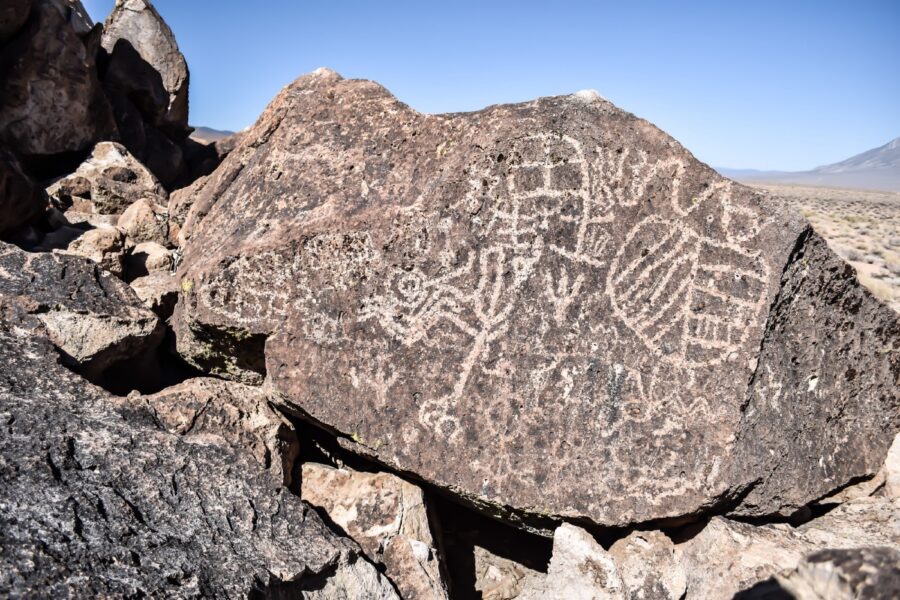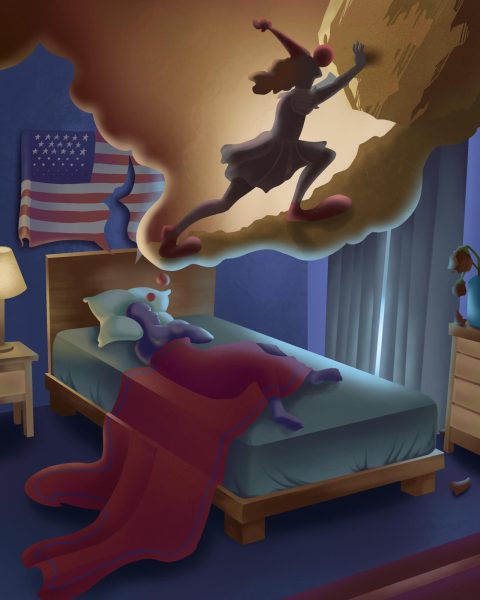Bouldering across lava fields in search of lost art
Story and photos by Adam Ernesto Fuentes
The morning started around a campsite. Behind the grass clearing the muted sound of the Owens River could be heard carving away at the valley floor. Surrounding the Pleasant Valley Campgrounds are the Eastern Sierra Mountains of Yosemite National Park to the west, and to the east, the White Mountains that border Nevada. Tablelands of volcanic ash and rock left over from a violent eruption of the Long Valley Caldera 760,000 years ago fill the expanse of land between the two mountain ranges like a glacier of black rock. The eruption covered thousands of square miles in lava and blanketed the American West in a thick layer of ash as far away as the Mississippi River. Over hundreds of thousands of years, the waters of the Owens River and its tributaries carved a valley deep into the lava fields creating a volcanic plateau known as Bishop Tuff north of Bishop, Calif.
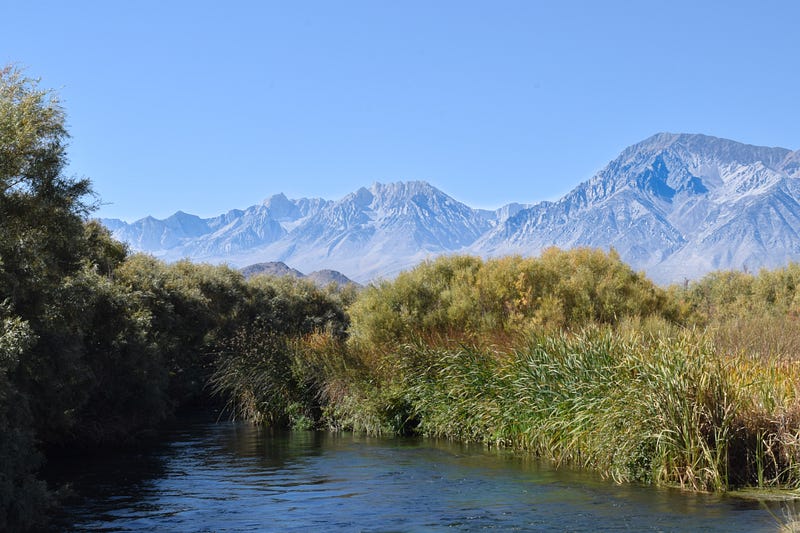
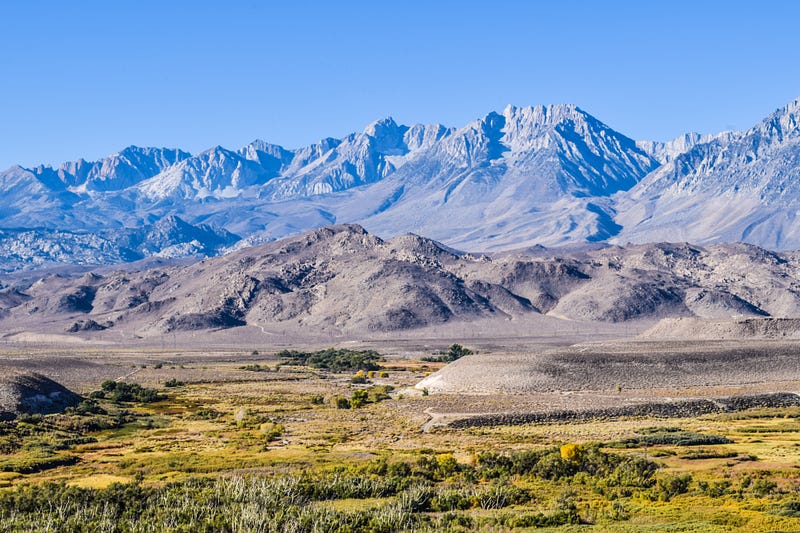
The Paiute-Shoshone people made this dynamic landscape their seasonal home as they hunted various migratory animals for over 10,000 years. Throughout the Owens Valley, their ancestors began to carve petroglyphs into the soft rock; perhaps for practical reasons such as astronomical calendars, or communicating with other travelers by leaving signposts behind, or as ceremonial symbols from visions of a spirit journey. Some symbols are vaguely recognizable as corn stalks, hunters, longhorn sheep, deer, and celestial calendars; others are more cryptic and resemble concentric circles, crosses, and grids. Unfortunately some of the petroglyphs have been vandalized or chiseled off and stolen. In an effort to conserve the remaining sites, both the federal government and the locals have removed the locations from maps and websites.
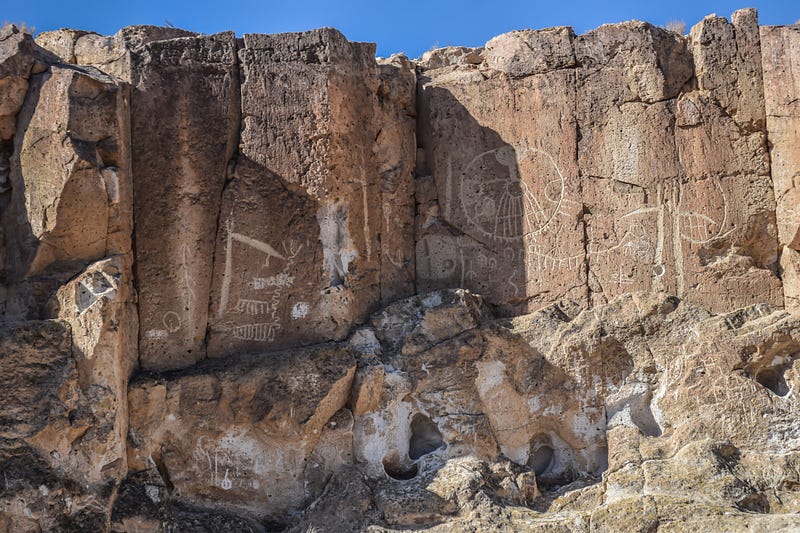
Where the maps ended, the adventure began. Our guide, Allan Der, spent countless days prior to the trip trekking through the volcanic tablelands searching for elusive petroglyph sites hidden from the general public by their remote locations. After everyone gathered at the campsite we took a five-car caravan eastward across the valley. To the right, the White Mountains folded over like smooth, round wrinkles of linen on the valley. Along the way, fenced-off land displayed signs claiming ownership by the city of Los Angeles. I wondered why a city 267 miles away would own so much land on a seemingly arid countryside. Our first destination was the Chalfant Site, a long quarter-mile stretch of volcanic cliff side with over 400 petroglyphs etched into the stone above a dry riverbed. The native art dates back to about a thousand years and depicts monolithic scenes of celebrated hunts and every day living of the ancient people who resided there.
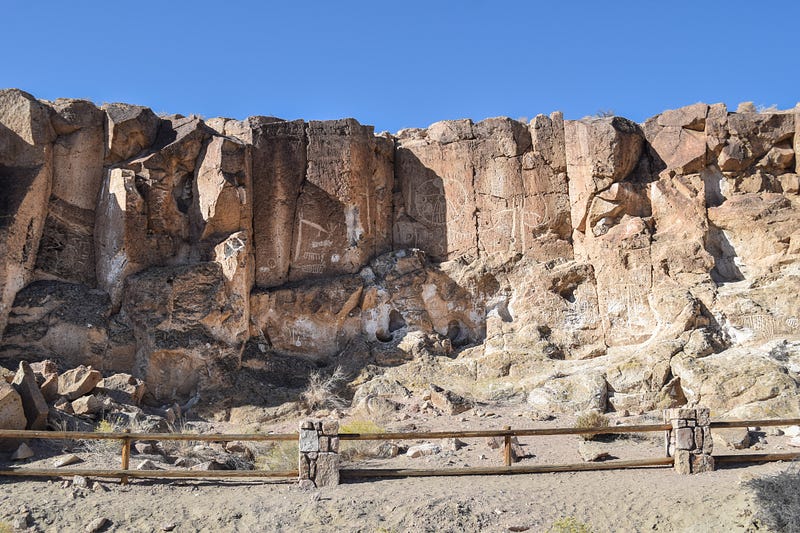
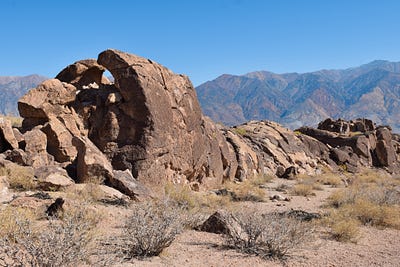
Further north lay an arrangement of rocks called Red Rock Canyon. It is a boulder maze of rock formations in the middle of the valley resembling the exposed spine of a buried dragon. It takes about an hour to walk around the site; however, the greatest concentration of petroglyphs is on the north facing side toward the end of the loop. There, one can discover jellyfish-like drawings, bird-like symbols, handprints and oddly geometric shapes resembling alchemy symbols.
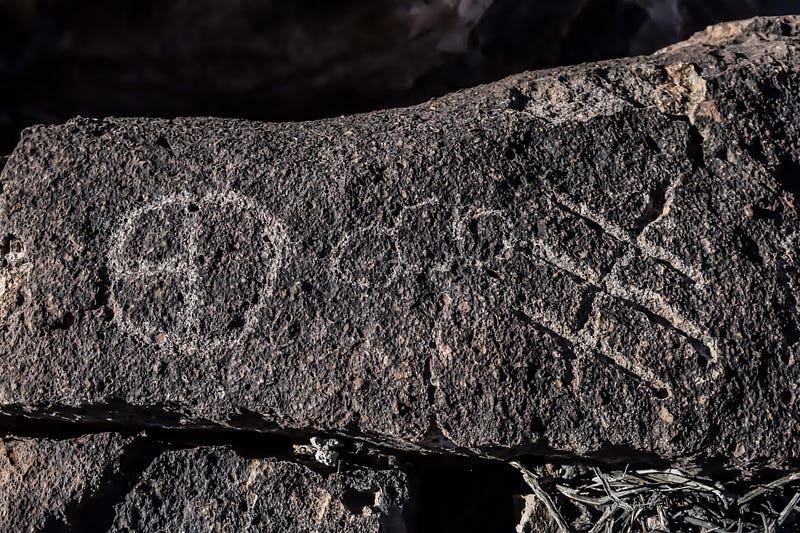

Southward, past the Los Angeles private property signs, is a group of densely packed petroglyphs near Chidago Canyon. The carvings are very compacted and overlap in some areas. This site is believed to have been a major communication hub to the ancients and it is presently referred to as “Newspaper Rock.”
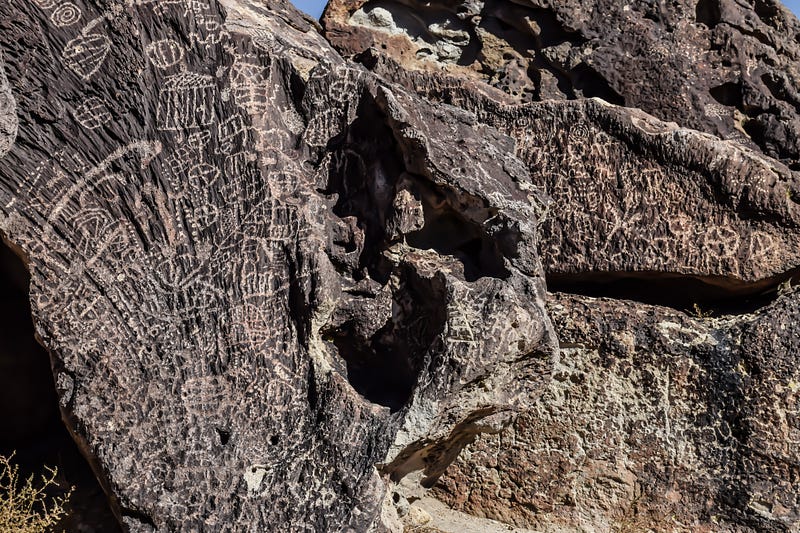
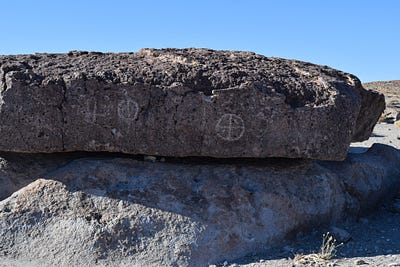

Next, we doubled back southward heading toward Bishop for the final site of the day. Fish Slough is an oasis on the valley floor. A fault line runs underneath pumping water to the surface were fish have been known to breed in the muddy waters. The climate here has not changed in over 100,000 years. Today, the oasis is fenced in as private property where cattle now graze. It is very evident that this site was a camp for the Paiute-Shoshone people. Fish Slough does not contain many petroglyphs compared to other sites, but it is rich in archeological artifacts that hint at prehistoric life. Grinding stones are arranged across the site where nuts and seeds were collected and turned into food. Further up the site, flat rocks were arranged into semi-circular formations and used as cover to ambush incoming prey. The layout of the camp indicates a great deal of planning and collaboration between the ancient villagers in complex social organizations.
We returned to Bishop at sundown. Under the cover of night the town loses its small town charm and feigns the character of a horror film set. Besides the reservation casino and a couple tacky bars, there is no nightlife in town. I befriended a local, Ruben, a bartender from Reno, who suggested I go to Keough Hot Springs, a hangout where local teenagers go to do what teenagers do. The springs are eight miles northwest of town and powered by the same underground volcanic activity that drives the fault lines and gives rise to the Sierras. The pools at the foot of the hills are just barely lukewarm. The higher the elevation, the tougher the climb, and the warmer the springs.
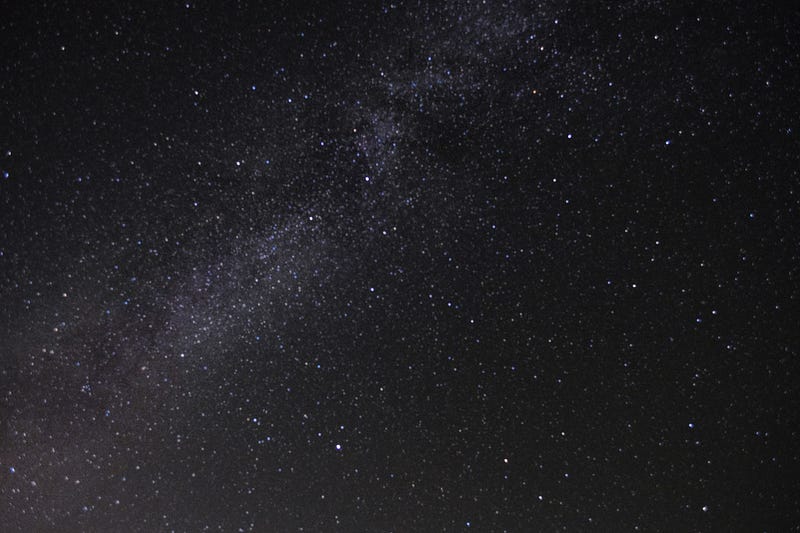
Out there, I was alone with my thoughts for miles in all directions. I witnessed the Milky Way traverse the night sky in complete darkness and isolation. But the serenity of the moment was occasionally interrupted by rattling in the bushes, and the unsettling fact that I was indeed… alone with my thoughts for miles in all directions. After taking a few long exposure shots of the night sky, I headed back to the Thunderbird Motel where I had checked in for the weekend. The hotel opened in 1968 and is operated by an Indian family living onsite in a house behind the reception desk. At night the aromatic scent of Biryani billowed through the parking lot as the family readied for supper.
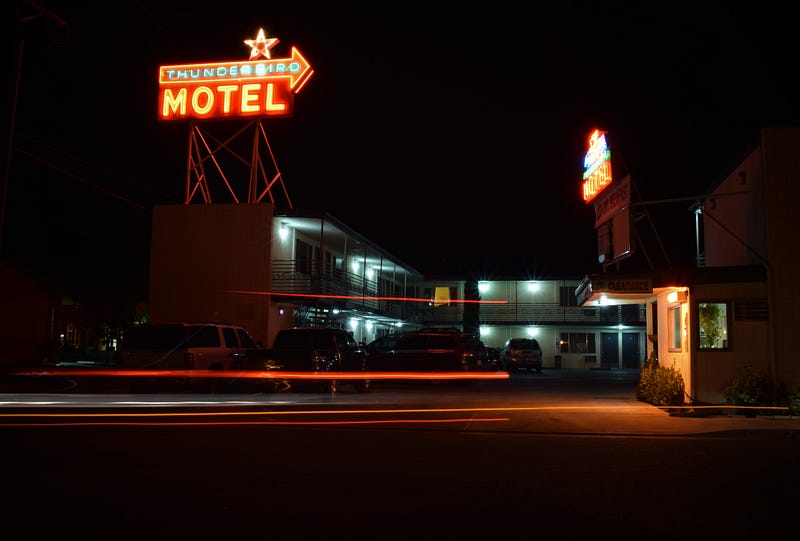
I started my morning the following day with an Italian affogato, ice cream covered in coffee, at the Black Sheep Espresso Bar & Café, a short walk from the motel. A mostly young crowd from Los Angeles on a bouldering trip awaited their orders. Service was fast, and I spent the time waiting on my order looking through the fine art photography displayed on the walls.

The air was brisk and the mountains appeared sharp and clear —a welcome change from the grey fuzz of air pollution endemic to the mountains of Southern California. Everyone met back at Pleasant Valley for the final hike of the trip. We took a short drive to the base of a volcanic plateau, parked our cars, and proceeded to climb the soft, ashy rocky side of the cliff in search of two remote petroglyphs sites- Sky Rock and 13 Moons. At the top of the plateau there are no obvious landmarks marking the way to Sky Rock. We followed Allan through an open space between a rock that leans on another rock. From that point on it is a bouldering climb to the site.
Sky Rock is an upward facing panel carved into the flat surface at the top of a huge boulder and very easy to miss among the other countless rocks that neighbor the area. It is curious how isolated this place was in relation to other petroglyph sites across the valley.

A short distance away, across a narrow depression in the plateau southeast of Sky Rock, is another panel carved into the flat face of a boulder called 13 Moons. This, the final site, was the most interesting, not only in composition but also in meaning. This site was used as an astronomical calendar. There are 13 moons in a given year and 13 moons drawn on the rock with other symbols carved around each moon, probably highlighting certain events that may have taken place during given times of the year. Standing next to this rock was a spiritual experience.
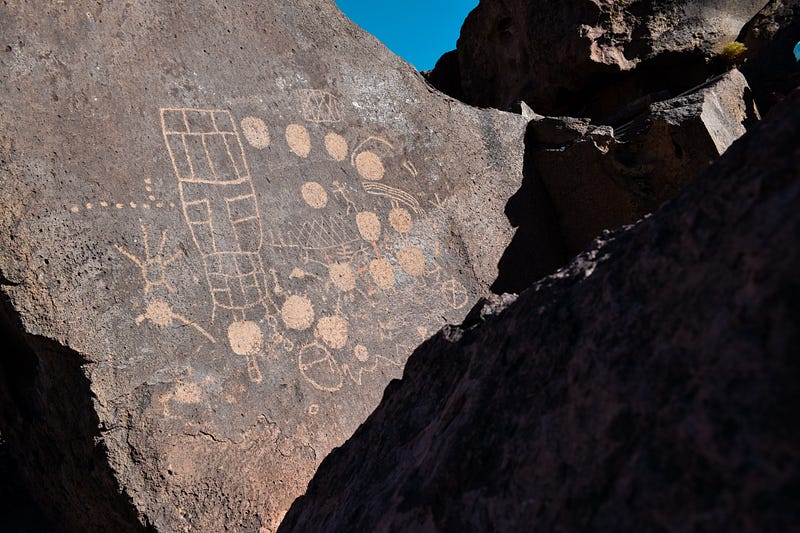
Owens Valley became a place of personal reflection. With the current degradation of our environment and the depletion of our natural resources, I look back to the earlier inhabitants of Owens, and wonder if we too can ever live in harmony with nature and ourselves, or will human history be told in our absence through the art we leave behind.
Substance is a publication of the Mt. San Antonio College Journalism Program. The program recently moved its newsroom over to Medium as part of a one-year experiment. Read about it here.

